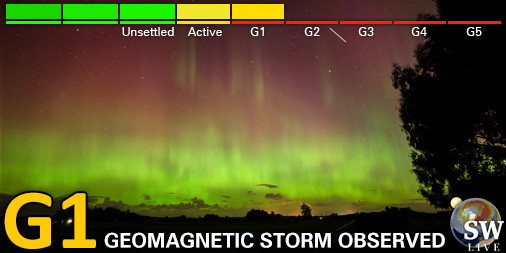Viewing archive of Friday, 23 October 1998
Solar activity report
Any mentioned solar flare in this report has a scaling factor applied by the Space Weather Prediction Center (SWPC). Because of the SWPC scaling factor, solar flares are reported as 42% smaller than for the science quality data. The scaling factor has been removed from our archived solar flare data to reflect the true physical units.
Report of Solar-Geophysical Activity 1998 Oct 23 2200 UTCPrepared by the NOAA © SWPC and processed by SpaceWeatherLive.com
Joint USAF/NOAA Report of Solar and Geophysical Activity
SDF Number 296 Issued at 2200Z on 23 OCT 1998IA. Analysis of Solar Active Regions and Activity from 22-2100Z to 23-2100Z
SOLAR ACTIVITY WAS LOW. REGION 8365 (S27W61) CONTINUED
TO PRODUCE SUBFLARES BUT AT A REDUCED RATE FROM THE LAST TWO DAYS.
GROWTH IN THIS REGION APPEARS TO HAVE STABILIZED.
IB. Solar Activity Forecast
SOLAR ACTIVITY IS EXPECTED TO BE LOW.
C-CLASS ACTIVITY IS POSSIBLE IN REGION 8365.
IIA. Geophysical Activity Summary 22-2100Z to 23-2100Z
THE GEOMAGNETIC FIELD RANGED FROM QUIET TO ACTIVE. THE ACTIVITY
ASSOCIATED WITH THE NORTHERN POLAR CORONAL HOLE APPEARS TO BE
ENDING. THE GREATER THAN 2 MEV ELECTRON FLUX WAS HIGH.
IIB. Geophysical Activity Forecast
THE GEOMAGNETIC FIELD IS
EXPECTED TO BE QUIET TO UNSETTLED.
III. Event Probabilities 24 OCT to 26 OCT
| Class M | 10% | 10% | 10% |
| Class X | 01% | 01% | 01% |
| Proton | 01% | 01% | 01% |
| PCAF | GREEN | ||
IV. Penticton 10.7 cm Flux
Observed 23 OCT 113 Predicted 24 OCT-26 OCT 112/112/115 90 Day Mean 23 OCT 132
V. Geomagnetic A Indices
OBSERVED AFR/AP 22 OCT 012/018 ESTIMATED AFR/AP 23 OCT 012/015 PREDICTED AFR/AP 24 OCT-26 OCT 010/012-010/010-010/010
VI. Geomagnetic Activity Probabilities 24 OCT to 26 OCT
| A. Middle Latitudes | |||
|---|---|---|---|
| Active | 15% | 15% | 15% |
| Minor storm | 05% | 05% | 05% |
| Major-severe storm | 01% | 01% | 01% |
| B. High Latitudes | |||
|---|---|---|---|
| Active | 15% | 15% | 15% |
| Minor storm | 05% | 05% | 05% |
| Major-severe storm | 01% | 01% | 01% |
All times in UTC
Current data suggests there is a slight possibility for aurora to appear at the following high latitude regions in the near future
NuukTórshavn
Oulu
Reykjavik
Trondheim
Kiruna, Luleå
Latest news
Latest forum messages
Unexplained proton activity 56Unspecified geomagnetic activity 2192AR4048 110SolarMax and FRAM2 2Changelog/Featurelog 169
More topicsSupport SpaceWeatherLive.com!
A lot of people come to SpaceWeatherLive to follow the Sun's activity or if there is aurora to be seen, but with more traffic comes higher server costs. Consider a donation if you enjoy SpaceWeatherLive so we can keep the website online!

Latest alerts
00:15 UTC - Geomagnetic activity
Minor G1 geomagnetic storm (Kp5) Threshold Reached: 23:59 UTC
Thursday, 3 April 2025
20:15 UTC - Geomagnetic activity
Minor G1 geomagnetic storm (Kp5) Threshold Reached: 20:02 UTC
13:03 UTC - Hemispheric Power Index
The OVATION model predicts the Hemispheric Power Index to reach 50GW at 13:56 UTC
Wednesday, 2 April 2025
04:03 UTC - Hemispheric Power Index
The OVATION model predicts the Hemispheric Power Index to reach 50GW at 04:56 UTC
01:45 UTC - Geomagnetic activity
Active geomagnetic conditions (Kp4) Threshold Reached: 01:32 UTC
Space weather facts
| Last X-flare | 2025/03/28 | X1.1 |
| Last M-flare | 2025/04/01 | M2.5 |
| Last geomagnetic storm | 2025/03/27 | Kp5 (G1) |
| Spotless days | |
|---|---|
| Last spotless day | 2022/06/08 |
| Monthly mean Sunspot Number | |
|---|---|
| February 2025 | 154.6 +17.6 |
| April 2025 | 152.5 -2.1 |
| Last 30 days | 130.6 -15.9 |





